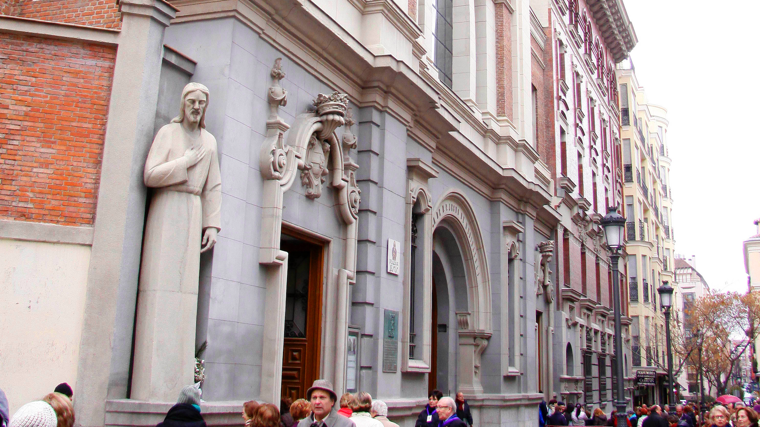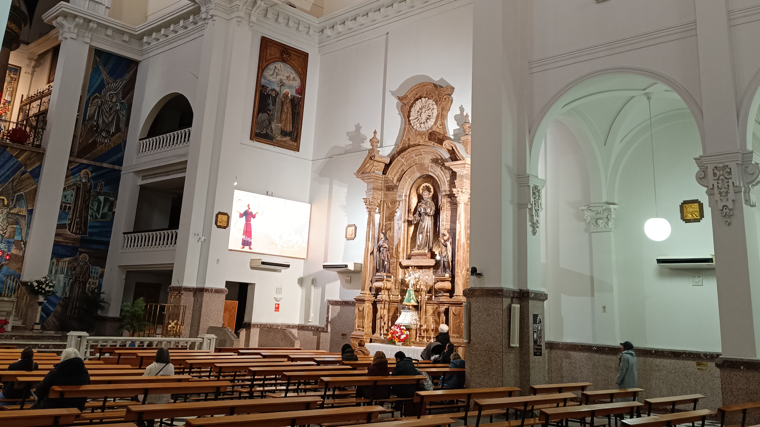Located at number 2 of Plaza de Jesús, in the Las Letras neighborhood, it is located the Basilica of Jesus of Medinaceli –one of the five that the capital has–, a religious space famous and loved for housing the Nazarene Christ of the 17th century from Medinacelian image of great devotion among Madrid residents.
This temple was built between 1922 and 1929 on the land occupied by the old convent of the barefoot trinitarians of Our Lady of the Incarnationwhich was founded in 1606 by the Duke of Lerma Francisco Gómez de Sandoval. Later, its patronage passed to the Dukes of Medinaceli and it was used to guard the image of Jesus rescued by the Trinitarians in 1682 from captivity in Fez and which today presides over the High Altar. The story told about his rescue increased its popularity, the one in which Sultan Muley Ismael asked for this figure to be weighed in gold and miraculously the scales did not weigh what he expected, but the equivalent of 30 coins – the same price for which Judas sold Christ – which allowed him to be brought back.
Image of the Nazarene Christ of Medinaceli
The current church was solemnly consecrated on November 21, 1930 and in September 1973 Pope Paul VI He elevated the temple to a minor basilica. Currently, it is governed by a community of the Order of the Capuchin Brothers and it is the canonical headquarters of the Primary Archconfraternity of the Royal and Illustrious Slavery of Nuestro Padre Jesús Nazareno de Medinaceli.
temple architecture
The first project of the basilica that was carried out in 1921, the work of Carrasco-Muñoz, showed a very elongated longitudinal plan with a façade to the Plaza de Jesús, but six years later a new project was presented that would change the direction of the works to ending with a more complex floor plan that joins a rectangle with a triangle and gives way to a large open space surrounded by columns for the three naves. In the upper part of the presbytery is the dressing room where the image of Christ of Medinaceli is venerated.

Exterior of the Basilica of Jesus de Medinaceli
From the outside, its baroque style façade topped by a large triangular pediment stands out. While inside, the stained glass window in its large window draws attention, in which an Apotheosis of the titular Christ is represented with several scenes from its history and several mosaics. by the artist Santiago Padrós Elías that represent scenes of the devotion of the people of Madrid to their Christ.

Interior of the Basilica of Jesus de Medinaceli
A musical legacy of more than 70 years
Since last December the basilica has once again enjoyed heavenly music since its organ has been completely restored. This instrument was purchased in 1952 in one of the best houses that existed at the time, that of Juan Duarte, in Bilbao and since then it had been modified several times, but in recent years it was already in poor condition, which led to requesting a new renovation that began a couple of years ago and in which they have dedicated themselves more than 24,000 hours of work.
The process has been led by the Austrian company Rieger-Orgelbau –a world reference in the restoration of historic organs–, who have incorporated technical innovations to adapt the instrument to modern acoustic demands, always respecting the tradition of the original organ builder. In total they have been meticulously restored and tuned 6,000 tubes. Now, it has 92 records (including 10 broadcast, 8 extensions and one acoustic), 44 of them new. Furthermore, the boxes have been turned so that the front, more splendid side becomes the façade of the new organ.

Images of the restored organ
Curiosities
– On the first Friday of March, a kissing of the image is celebrated, attended by thousands of Madrid residents.
– The image of Christ is 1.73 meters high and was carved in Seville, which explains why its iconography corresponds to that of the Christs known as ‘of the sentence’.
– An organ with the characteristics of the one this temple has can take three years of work and cost close to a million euros.
– Since this year the basilica has its own website basilicadejesusdemedinaceli.org
– During 2025 they have an initiative called ‘Sponsor a tube’, a project that will last until 2025, offering the possibility of symbolically sponsoring the almost 6,000 pipes of the recently restored organ to cover the costs of this work and contribute to the conservation of this significant musical heritage.
#Music #plays #Basilica #Jesús #Medinaceli



